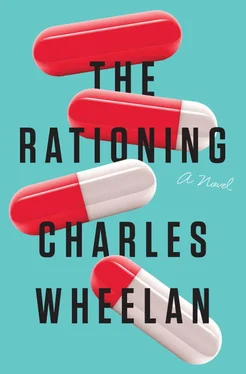THE NIH WORKING GROUPS WERE ENERGIZED BY MY THEORY of how lurking viruses might work, but the response was still less robust than one might think. The working hypothesis was that proximity to the dust mite was somehow protective against the virulent form of Capellaviridae . To stick with the earlier analogy, the dust mite is the extortionist; humans are the hostages; and somehow Capellaviridae is the weapon the dust mite uses to advance its own interests. One can imagine the dust mite holding the Capellaviridae “gun” to the head of its human host, saying, “As long as I stay fed and comfortable, nobody gets hurt.” If humans start to wipe out the pesky dust mite, however, things would turn ugly. (My hypothesis was that moving away from an area with dust mites to one without them somehow sent the signal that the dust mite was under siege, kind of like the protagonist in a western saying, “If I’m not back safely in an hour, kill them all.”)
“I understand all that,” the NIH Director told me, “but I need you to understand that it takes time to test a hypothesis that is still only half-baked.”
“Half-baked?” I asked incredulously. “Have we got any ideas that are fully baked?”
“I’m sorry, that was a poor choice of words,” she said. “I’ve been talking to people at the FDA all morning. A clinical trial typically takes months, if not years. You’re asking me to do something in days that usually takes years, and to be honest, it’s not even clear what we’re testing.”
I paused for a moment before responding. For most people, that involves some kind of cooling-off process. Unfortunately, I was heating up. “First of all,” I began, trying to project anger and seriousness without any hint of hysteria, “I’m not asking you to do anything. The people who are likely to die from Capellaviridae are asking you to do something. Second of all, what we’re testing here is really simple. Just expose people who’ve become sick to the North American dust mite. The hypothesis is that somehow repeated exposure to the dust mite protects against Capellaviridae turning virulent. I can’t tell you how or why that will work, and frankly we shouldn’t care at this point. We can figure that out five years from now and we’ll all share the Nobel Prize. We just need to try this very simple fix because we have nothing else.”
Now it was her turn to pause and sigh. “It’s not that simple,” she said in a tone that suggested I probably would not get it anyway, like a high school girlfriend who says pityingly, “Oh, you’ll never understand…”
“Which part of just letting people get bit by dust mites is not simple?” I asked angrily.
“Let’s start with ‘who,’” she said. “Who is in this trial? We have no federal protocol for this kind of situation. We have a treatment that is one hundred percent effective—Dormigen. Anyone who is sick now or becomes sick in the next few days will receive Dormigen. Meanwhile, we have a completely untested theory that involves exposure to biting insects—something that hasn’t even been tested on rats. Would you volunteer for that clinical trial? Would you enroll your children? ‘Oh, no, Bobby doesn’t need Dormigen, let’s try the biting-bug cure.’”
“That’s not fair—”
“I’m not done yet,” she snapped. “We can’t test this on people without their knowledge, obviously.” I was being reminded that the Director was tough and smart; one does not get to be the head of a federal agency without heavy dollops of both of those attributes. Also, she had had as little sleep as the rest of us, maybe less. “Now let’s talk about ‘how,’” she continued. “Even when Capellaviridae becomes virulent, the body fights it off about ninety-nine percent of the time. So to determine if a treatment is effective with any degree of statistical confidence, we need a huge sample. And I just finished telling you that we’re having some trouble finding anyone who would be in that sample.”
“I’m sorry,” I said, raising the white flag. “We’re on the same team here.”
“Then stop telling me how to do my job,” she said angrily. My apology worked to soften her tone, but she needed to wind down, like an engine that continues to run for a few seconds after the ignition has been turned off. “Also, I have to deal with that French asshole.”
“Giscard?” I asked.
“Yeah, he’s here.”
“Like in D.C.?” [24] In her accounts of this conversation, the NIH Director has maintained repeatedly that I asked her, “Who invited Giscard?” That is not what I said. I do not like Giscard personally, and our feud is now public, but I would never have spoken in a way that suggested a scientist of his caliber should be excluded from our efforts to deal with the Outbreak.
“Yeah, he took it upon himself to fly over when he heard the news,” she offered. “He got in last night.”
Lionel Giscard was—by science standards—a global celebrity. He was the lead author on not just one, but two of the key papers that led to the development of Dormigen. He had won about every major science award and was dusting off a place for the Nobel Prize medal (which is typically awarded near the end of one’s career). Within the scientific community, Giscard was considered a lecherous asshole, for lack of a politer way of saying it. He had been married four times; after his most recent divorce, he was photographed cavorting with a former graduate student of his who was younger than all of his children. His starter wife was a doctor; they had met at university. Each subsequent relationship involved a search-and-replace process in which he sought out the most attractive graduate student and made her the new Madam Giscard. He stunned a conference of microbiologists—I mean, left a room of two hundred just stone-silent—when he opened a talk on cell longevity by saying, “I must have found the key to eternal youth, because the woman I am married to never seems to get any older.” [25] You can watch the YouTube clip, which includes not just the remark (in French) but also about five seconds of audience reaction during which the scientists look around in shock.
There was not even uncomfortable laughter.
Giscard eventually found his way to Harvard, where the university built and funded a laboratory for him. This became a cause célèbre on campus, as Giscard’s pattern of behavior was already well established before Harvard recruited him. (Yes, he had married some of his protégés, but most of the attractive graduate students who had been the recipients of his amorous advances had no interest in becoming the next Madam Giscard.) He made it barely four months in Cambridge before a laboratory assistant alleged that he had pressed his body up against her and smelled her hair while she was looking at a microscope. This was a tough case to make, as people do bump into one another in close quarters, and sniffing hair (wildly parodied in the Harvard Lampoon ) is not generally a firing offense. Still, Harvard’s president decided this was not a work environment that should be encouraged. Perhaps more important to the resolution of the situation, Giscard decided he was not happy at Harvard, either. In a remarkably telling comment, he told a reporter at the Harvard Crimson , “No one has ever complained before.”
There were no quibbles over Giscard’s scientific talent. He was not a brilliant theorist; rather, he had a brilliant ability—and I am not using the word “brilliant” lightly—to absorb a theory and digest it into smaller, more actionable pieces. This was his contribution several times over in the development of Dormigen. On the other hand, Giscard’s colleagues did quibble—more than quibble, actually—about his prodigious ability to appropriate credit for major breakthroughs. When teams of researchers were tackling similar problems at different universities, as is often the case in academe, Giscard’s papers always seemed to get published first, often with the results advertised to the press before the peer review process was complete. And when those papers were published, he always demanded to be first author, regardless of his actual contribution. It was not negotiable.
Читать дальше












